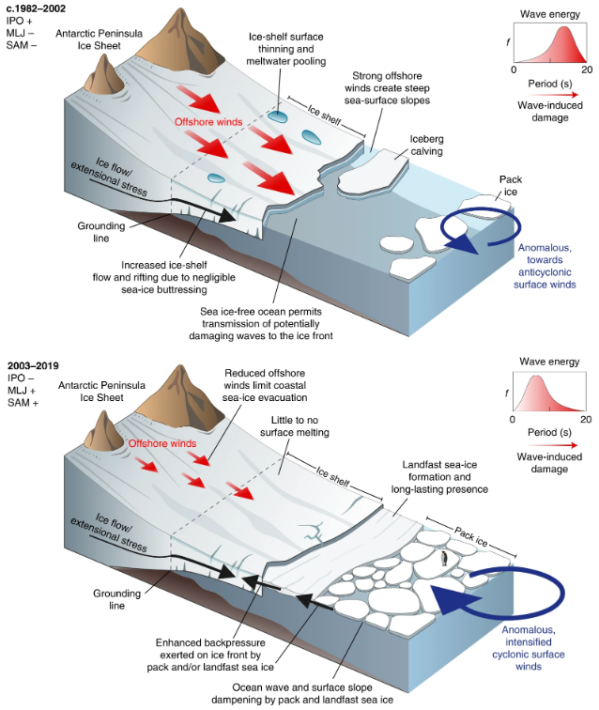The Larsen ice shelves extend along the east coast of the Antarctic Peninsula over the northwest part of the Weddell Sea. From north to south, these segments are called the Larsen A, B, C, and D, bordered by Filchner–Ronne Ice Shelf south of the Weddell Sea. In 1995, the Larsen A ice shelf completely disintegrated,... Continue Reading →
Sea-ice retreat may invigorate the weakening Atlantic Meridional Overturning Circulation
Due to rapidly rising air temperature over the Arctic and subarctic regions, the ocean-to-air turbulent (i.e., sensible and latent) heat flux over the Greenland, Iceland, and Norwegian Seas (GINS) has diminished (i.e., less cooling of the surface ocean) steadily during the satellite period (i.e., since the 1970s). This may lead to a reduction of deep... Continue Reading →
Increasing influence of warm and salty Atlantic water on the cold season Arctic sea ice melting
The Arctic Ocean in the upper 100 - 200 m is typically characterized by a cold and fresh surface mixed layer and a layer of rapidly increasing salinity with depth, as known as halocline, separating the surface mixed layer from the warm and salty Atlantic water at depth. Due to large vertical density gradient and... Continue Reading →
Recent recovery of the Antarctic Bottom Water and its contribution to the Global Meridional Overturning Circulation
The lower limb of the Global Meridional Overturning Circulation (GMOC) is supplied by the sinking of the heavy water mass that forms around the Antarctica, known as the Antarctic Bottom Water (AABW). Repeat hydrographic data along the Atlantic, Pacific and Indian Ocean sections observed during the mid 1990s, 2000s and 2010s indicate that the volume... Continue Reading →
Enhanced carbon sequestration by the North Atlantic Ocean during the Last Glacial Maximum
According to Redfield stoichiometry, marine organisms incorporate and release PO4 and Dissolved Inorganic Carbon (DIC) in a relatively fixed proportion. Additionally, PO4 in the ocean is not affected by air-sea exchange. Therefore, PO4 and DIC in the ocean can be used to estimate biology-driven versus air-sea flux-driven oceanic DIC redistributions. Applying this method to sediment core data, a new paper... Continue Reading →
Glacial weakening of the AMOC and the associated increase in deep ocean carbon deposit
During the mid-Pleistocene between 1,250 and 700 kyr ago (ka), Earth’s climate oscillated between warmer interglacial periods and cooler glacial periods with reduced and expanded polar ice sheets, respectively. Paleo records indicate that the Atlantic meridional overturning circulation (AMOC) was relatively weaker during glacial periods likely due to reduced evaporation and increased freshwater input from glaciers to the... Continue Reading →
Ocean storage of anthropogenic CO2 from 1994 to 2007
A paper published in Science estimated the oceanic sink of the anthropogenic CO2 (Cant) over the period of 1994 to 2007 by comparing observations collected from global repeated hydrography cruises between 2003 and 2007 to those from the World Ocean Circulation Experiment (WOCE) and Joint Global Ocean Flux Study (JGOFS) program during the 1980s and early 1990s. The... Continue Reading →
Natural variability in the Southern Ocean as a driver of the observed Antarctic sea-ice expansion trends
A team of scientists from Princeton University, NOAA-GFDL, and UCAR performed global climate model simulations, using a newly developed coupled ocean–atmosphere model SPEAR (Seamless System for Prediction and Earth System Research). When this model was driven with changes in past radiative forcing, the model simulation did not reproduce the observed increasing trends in sea-ice concentration around... Continue Reading →
Deglacial atmospheric CO2 increase caused by enhanced abyssal circulations in the Pacific Ocean
Paleo records indicate that during the last deglaciation period (19,000–9,000 years ago) atmospheric CO2 level increased by about 80 ppm. A new study published in Nature Geoscience analysed neodymium (Nd) isotope data in North Pacific sediment cores to find an increase in 14C age of North Pacific subsurface waters sourced from Antarctica indicating an enhanced abyssal overturning... Continue Reading →
Antarctica and the Southern Ocean in 2070, under low and high emissions scenarios
A team of experts in biology, oceanography, glaciology, geophysics, climate science and policy, analyzed the potential impacts of two different future scenarios of carbon emissions, RCP2.6 (low emission & strong action) and RCP 8.5 (high emission & weak action), on Antarctica and the Southern Ocean. The team assessed key systems including global average air temperature; Antarctic contribution... Continue Reading →








